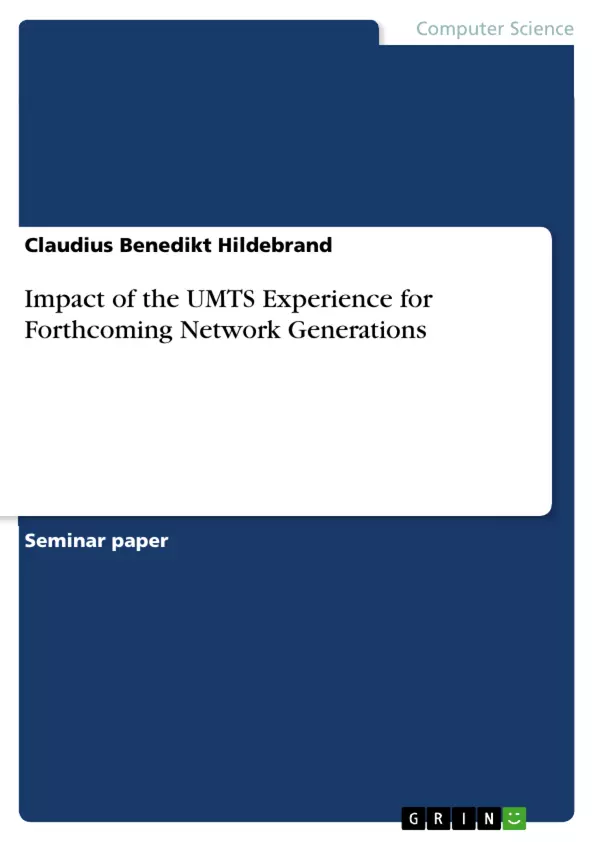This paper evaluates the impact of the UMTS experience for forthcoming network generations. Therefore, it is necessary to show the development of mobile networks from the beginning on. During the evolution process, formerly analogue networks transformed to digital ones with more and more services that added value to customers’ life and consequently became very popular. In these days, mobile operators are trying to migrate their second generation networks to third generation which was supposed to be a globally accepted standard offering high data transfer speeds. However, an in-depth look at the technical and financial background of the 3G implementation shows that provider promises and user expectations differ. This will not only affect 3G, but also upcoming network generations like 4G. In the following, continuous delays in the 3G launch and advanced research in 4G technology in combination with upgrades to existing 2G network infrastructure are discovered as threads questioning the success of 3G.
Table of Contents
- Introduction
- Problem Definition and Goals of the Study
- Outline
- The Evolution Path to 3G Cellular Networks from a Historical Perspective
- First Generation - The Stone Age of Mobile Communications
- Second Generation - Entering the Mediaeval Times of Digital Mobile Communication
- Third Generation
- Stepping into a new Generation of Mobile User Expectations and Mobile Service Provider Promises of 3G Systems
- Organizational and Technological Requirements of 3G Systems
- Billions for Fresh Air - Licensing of Frequencies
- Implementation and Roll-Out of 3G Systems
- Comparison between User Expectations and the actual Experience
- Fourth Generation – The Future of Mobile Communications
- How to define 4G?
- The Idea behind 4G
- Credibility of Mobile Provider's Promises
- Current State of 4G Technology Research
- The x.5 Generations – Technological Milestones or Human Failure at Technological Challenges
- 2.5G The next step towards Delivery of Multimedia Content to Handheld Devices or just "UMTS-light"?
- 3.5G - Is an improved Version of 3G necessary to offer Features that we were promised by UMTS itself?
- Using Seven League Boots to jump from 2.5G to 4G?
- Conclusion
Objectives and Key Themes
This seminar paper examines the evolution of cellular network technology, focusing on the development and implementation of 3G (UMTS) and the anticipated transition to 4G. The goal is to analyze the gap between user expectations and actual experiences with 3G networks, and to evaluate the credibility of promises made for future generations of mobile communication. Key themes explored in this study include:- Historical development of mobile communications
- Technological advancements and challenges in 3G and beyond
- User expectations and the reality of mobile service delivery
- The role of mobile providers in shaping technological development
- The potential impact of future generations of mobile communications
Chapter Summaries
The first chapter introduces the study's focus on the impact of 3G network experiences on future generations, outlining the problem definition and goals. Chapter two traces the evolution of mobile communications from the first generation to the advent of 3G, highlighting the historical development and key technological milestones. Chapter three delves into the details of 3G technology, exploring user expectations, organizational and technological requirements, and the challenges of frequency licensing and network rollout. The fourth chapter focuses on 4G, exploring its definition, the underlying concepts, the credibility of mobile provider promises, and the current state of research. The fifth chapter examines the significance of the "x.5" generations, considering whether these represent meaningful advancements or merely incremental improvements on existing technology. Finally, chapter six considers the potential for a rapid leap from 2.5G to 4G, while acknowledging the complexities of such a transition.Keywords
Mobile communication, cellular networks, 3G, UMTS, 4G, 2.5G, 3.5G, user expectations, technological advancements, network rollout, mobile service providers, future technologies, historical evolution.- Quote paper
- Claudius Benedikt Hildebrand (Author), 2003, Impact of the UMTS Experience for Forthcoming Network Generations, Munich, GRIN Verlag, https://www.grin.com/document/19701



